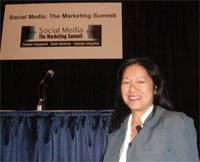Charlene Li, co-author of Groundswell, and former Forrester analyst, has recently launched her own company, the Altimeter Group. This week, she gave a keynote at the Social Media Marketing Summit 2008, San Francisco. Known for her commitment to social media, and belief that marketing and advertising are fatally flawed, Li started with a Google search on ‘Comcast’. The ninth result is a YouTube video titled: A Comcast technician sleeping on my couch.

“This is why social media is so important,” Li said, “this YouTube video recorded by ‘Brian’ resulted in the Comcast brand going down the toilet. You must understand that the power is now in the hands of consumers.“
Marketing is Changing
Marketers today are caught up in a jumble of buzzwords that mean very little. It’s a confusing time, but to get the marketing right, you need to start thinking about relationships first. “It’s not about selling something anymore; that might be the end result, but to get there, you need to work on the relationship.”
One of Li’s favorite videos (below) shows the disconnect between advertisers and customers. “It really captures how advertisers see the world, and how consumers are asking for a divorce.”
So, how is marketing changing? What are best practices and pitfalls? How do you even start?
When creating your social strategy, Li recommends a four step process:
1. Who is your audience?
2. Very clear goal
3. Action plan
4. Tools, tactics, techniques
Determining Your Audience
To help you determine your audience, you need to consider their level of participation, and classify them according to how they use social technologies. Are they:

Non Active
Watchers: 52% of online users have watched YouTube, 42% have read blogs, 19% have downloaded podcasts
Sharers: 29% have used social networking sites, 28% have tagged online content, 21% have shared online content that they created
Commenters: 32% have rated a product, service or person, 30% have commented on a product, 22% have commented on newsgroup or site
Producers: 12% have created or worked on a blog; 11% have remixed content.
Curators: People that have edited a wiki – moderated a forum
Once classified, you can use that information to start building your community.
For instance, if your target audience is moms, you don’t approach them as producers; they’re not going to be at that level. However, studies have shown that moms are more likely to comment than any other person online because they value the thoughts of others and want to share their thoughts.
Be Very Clear on Your Target Goal
Set up an action plan. Much like at a dinner party, before you start talking, listen first. Find out what people are saying about you by using various online monitoring tools. Li uses Google blog search and Twitter to search for her brand online.
Once you determine what is being said about you online, you can take it to the next level and do something about it.
Companies That Utilize the Social Web Well
According to Li, some companies that use the Social Web well are:
Oracle
Prior to running Oracle Open World, Oracle changed its home page for two weeks. The page asked for consumer feedback; community involvement was important enough to interrupt the normal flow.
H&R Block
When H&R Block realized selling was no longer working, they created a page on FaceBook to provide tax advice. They don’t say “come and do your taxes with us,” on FaceBook; they only offer advice.
Comcast
Frank Eliason, Director of Digital Care for Comcast Cable uses Twitter to look for people talking about Comcast, ‘tweets’ them, and offers to help.
Skittles
Skittles has a page on FaceBook called ‘Mix the Rainbow’.
It’s created a spark and now the community is interacting with one another. The company occasionally steps in with light and fun comments; never with sales talk.
A recent series of messages on the Skittles wall:
Derek says: Is it just me, or does there seem to be too many orange ones in the bags now?
Skittles says: Derek despite what you or the Internet may think, we can assure you there is no orange skittles conspiracy – red on the other hand…
Starbucks
Starbucks asks for suggestions on how to make the company better. If you provide a suggestion, Starbucks CIO will discuss the idea on the site; it’s not just a black hole that suggestions go into. He explains the back end – or what has to happen on the technical level before they can implement the idea.
Wal-Mart
While most people cringe when they hear about Wal-Mart’s many failed attempts to get involved with their community online (think The Hub, Across America, FaceBook), Li gives them kudos for continuing to try when others may have given up. Look at ‘Check Out’ Wal-Mart’s latest offering; it took them a long time to get there, but now, this really works.
All of these companies are closing the loop. The traditional firewall separating customers and companies is falling away; no longer is it an ‘us’ and ‘them’ mentality; it’s now a ‘we’ mentality.
How do You Get Started?
The best way to begin is to go out and meet some revolutionaries. Talk to them, ask them what’s worked and what hasn’t. Take inspiration from them. Realize you cannot do this alone; go and get help.
Li’s disappointment with the advice she has seen on the Web has inspired her to begin the Altimeter Wiki, a list of consultants, social media boutiques, PR agencies, and interactive media agencies. Li encourages people working in the space to add their name, “there are no judgments at the moment, but there will be in the future.”
Recommendations on finding good help:
- Find groups that are focused on relationships, not campaigns
- Find agencies that are using social media successfully themselves
- Ask whether they commit resources to continued learning and training
- Ask whether they make mistakes (Li guarantees that if people are doing this correctly, they will make mistakes)
- Do they have respect for, and are humbled by the medium
In summary, Li walks through the “nitty gritty” details of the action plan:
- Who needs to buy in to the plan?
- Who will ‘own the community?
- What’s the right level of engagement (corporate vs. audience vs. product)?
- How will we deal with negative comments and customer service issues
- How much should we spend?
And her final tip? “Realize that you will have to give up the fallacy that you have control.”










